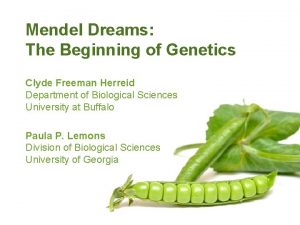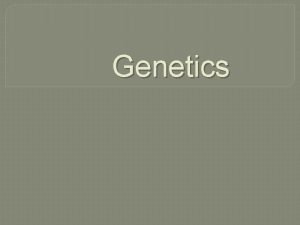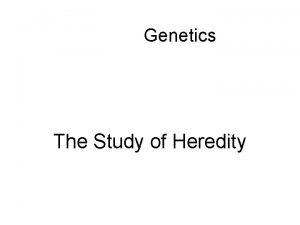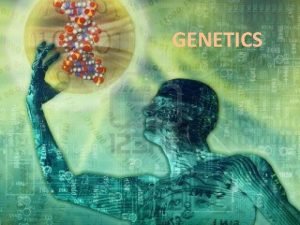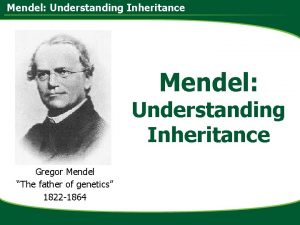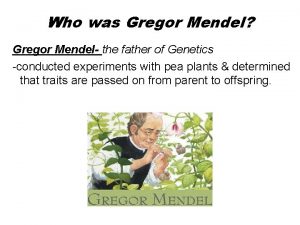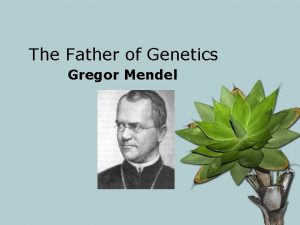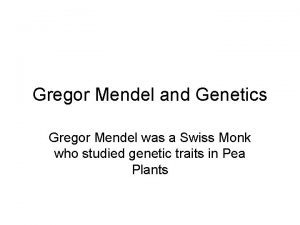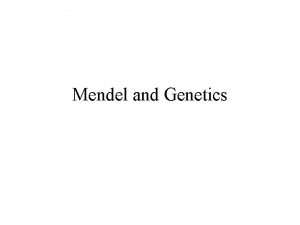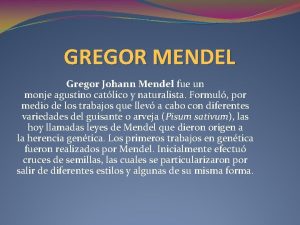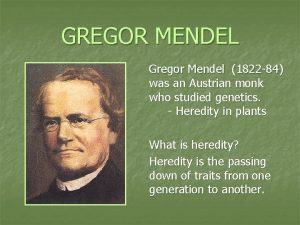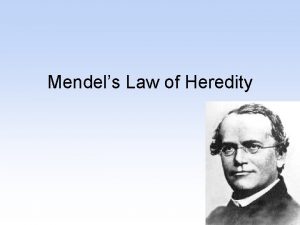Gregor Mendel and Inheritance The Father of Inheritance
















- Slides: 16

Gregor Mendel and Inheritance The “Father of Inheritance”

History of Mendel • Born 1822 • Attended University of Vienna • Studied biology, physics, and chemistry but did not graduate • Became an Austrian monk and there he investigated the inheritance of certain traits in pea plants

Why Pea Plants? ? ? • Peas grow and reproduce quickly • Peas mating can be controlled • Peas have a number of distinct traits that are readily observed

His studies continued… • Over the next 8 years, he conducted many experiments to observe the inheritance of traits • His conclusions became what is known as “Mendel’s Laws or Principles of Inheritance”

Before we get to the principles… • Mendel used tall and short pea plants for his experiments • The tall plants he worked with were from populations of plants that had been tall for many generations and had produced tall offspring • Same with the short plants


Mendel’s Crosses • Mendel crossed the tall and short plants to produce new plants, referring to the offspring as hybrids. • A hybrid is the offspring of parents that have different forms of a trait, such as tall and short height.

Mendel’s Crosses: The First Generation (F 1) • Mendel selected a six-foot-tall pea plant that came from a population of pea plants, all which were over six feet tall. • He crossed pollinated this tall plant with pollen from a short pea plant that was less than two feet tall, coming from a population of pea plants that were all short. • He found that all of the offspring grew to be as tall as the taller parent. It was as if the shorter parent had never existed.

Mendel’s Crosses: The Second Generation (F 2) • Mendel allowed the tall plants in the F 1 generation to self-pollinate • In this second generation, 3/4 of the plants were as tall as the tall plants • 1/4 of the offspring were as short as the short plants in the parent generation (P 1) • Ratio of about 3 tall plants to one short plant • The short trait had reappeared as if from nowhere.

Mendel’s Principles of Inheritance 1. The Principle of Genes in Pairs Genetic characters are controlled alleles (unit factors) that exist in pairs in individual organisms and are passed from parents to their offspring. When two organisms produce offspring, each parent gives the offspring one of the alleles from each pair.

Mendel’s Principles of Inheritance 2. The Principle of Dominance and Recessiveness When two unlike alleles responsible for a single trait are present in a single individual, one allele can cover up the expression of another allele; that is, one allele is dominant to the other, which is said to be recessive. (F 1 generation of tall plants – dominant trait = T, short plant – recessive trait = t)

Mendel’s Principles of Inheritance 3. The Principle of Segregation: During the formation of gametes (male and female sex cells; sperm and egg), the paired alleles separate (segregate) randomly so that each gamete receives one allele or the other. 4. The Principle of Independent Assortment: During gamete formation, segregating pairs of alleles assort independently of each other.

Phenotypes and Genotypes • When two organisms look and behave alike but have different gene combinations, they have similar phenotypes. This is the visible characteristic. • For example, the phenotype of a tall plant is tall, whether it is TT or Tt

Phenotypes and Genotypes • The gene combination an organism contains is its genotype • For example, the genotype of a tall plant that has two alleles for tallness is TT. The genotype of a tall plant that has one allele for tallness and one allele for shortness is Tt. • An organism’s genotype can’t always be known by its phenotype

Homozygous and Heterozygous Homozygous • When the two alleles for the trait are the same. • For example, the tall plant that has two alleles for tallness (TT) is homozygous for the trait of height. • Since tallness is dominant, a TT individual is homozygous dominant for that trait. A short plant (tt) is homozygous recessive for that trait.

Homozygous and Heterozygous • When the two alleles for the trait are different. • For example, the tall plant that has one allele for tallness and one gene for shortness (Tt) is heterozygous for that trait.
 Gregor mendel a monk
Gregor mendel a monk Who is gregor mendel and what is he famous for
Who is gregor mendel and what is he famous for Who is gregor mendel and what did he do?
Who is gregor mendel and what did he do? Section 11–1 the work of gregor mendel
Section 11–1 the work of gregor mendel Who is gregor mendel
Who is gregor mendel Gregor mendel's dream was to?
Gregor mendel's dream was to? Gregor mendel chart
Gregor mendel chart Chapter 12 lesson 1 the work of gregor mendel
Chapter 12 lesson 1 the work of gregor mendel Suit separate
Suit separate What did gregor mendel research
What did gregor mendel research What did gregor mendel do
What did gregor mendel do How many pairs of chromosomes
How many pairs of chromosomes Conclusion gregor mendel
Conclusion gregor mendel The work of gregor mendel lesson 1 chapter 12
The work of gregor mendel lesson 1 chapter 12 Chapter 11 biology test
Chapter 11 biology test Gregor mendel punnett square
Gregor mendel punnett square Gregor mendel plant
Gregor mendel plant





